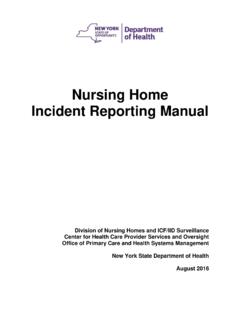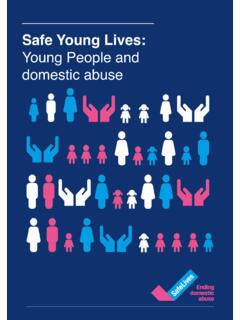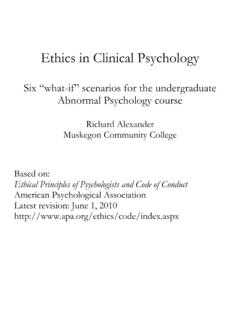Transcription of National Study on Online Sexual Abuse and Exploitation
1 National Study on Online Sexual Abuse and Exploitation of Children in the Philippines Cover photograph: UNICEF Philippines/2019/SNoorani Design and layout: Beetlebugs Communications, Inc. UNICEF Philippines 2020. Any part of this document may be freely reproduced with appropriate acknowledgement. National Study on Online Sexual Abuse and Exploitation of Children in the Philippines Proponents: Dr. Maria Caridad H. Tarroja Prof. Ma. Angeles G. Lape a Dr. Ethel C. Ong Dr. Ron R. Resurreccion Dr. Ma. Divina Gracia Z. Roldan CONTENTS I. Contents Acknowledgement ..iv Message .. v List of Acronyms .. vii Definition of Terms .. viii Executive Summary .. xii Introduction .. 1. Research Objectives .. 2. Research Questions .. 2. Review of Related Literature .. 4. Framework .. 14. Research Methodolgy.
2 16. Qualitative Research .. 16. Respondents .. 17. Data Gathering Procedure .. 19. Addressing Ethical Considerations .. 20. Data Analysis Strategies .. 20. Validation and Peer Review Process .. 21. Key Findings .. 22. Landscape of OSAEC in the Philippines .. 23. Awareness and Perception of OSAEC in the Philippines .. 23. Perception of the Extent of OSAEC in the Philippines .. 24. Different Technology Modalities that have Facilitated OSAEC .. 26. Child Victims .. 28. Profile and Characteristics of Children .. 28. Experience of Online Sexual Abuse and Exploitation of Children .. 29. Accessing the Internet, ICT, and Social Media .. 34. Gadgets and the web demystified and motivations for engaging in OSAEC .. 36. Impact of OSAEC Experience on Child Victims .. 37. Resiliency in the face of OSAEC: Picking up the pieces.
3 50. Role of the Family in the Promotion of OSAEC .. 52. Role of the Community in the Promotion of OSAEC .. 53. Role of Family in the Prevention of OSAEC .. 53. Role of Community in the Prevention of OSAEC .. 53. National Study on Online Sexual Abuse and Exploitation of Children in the Philippines II CONTENTS. Sociocultural environment by which OSAEC occurs in the Philippines .. 55. Child Protection Services in the Place that Give Assistance .. 56. Advocacy .. 59. Psychoeducation and prevention through coordination with schools .. 59. Coordination with Local Agencies .. 60. Empowering Families and Communities .. 60. Faith-based Organization Services .. 61. Research Dissemination and Policy .. 62. Offenders .. 62. Profile of Offenders .. 62. Some Insights on Offenders.
4 64. Experiences of Offenders and Their Previous Criminal Activities .. 65. Motivations of Offenders .. 66. Sense of Culpability of Offenders .. 66. Access of Offenders to Child Victims .. 68. Grooming the Victims .. 70. Mechanics of Offenders' Operations .. 71. Private Sector .. 76. Role of the Private Sector in Promoting OSAEC .. 77. Role of the Private Sector in the Prevention of OSAEC .. 79. Case Resolution and Management .. 81. Laws, Guidelines, and Regulations Protecting Children against OSAEC .. 87. Child Protection Policies .. 90. Gaps and Weaknesses in the Legal Framework .. 92. Stakeholders in Addressing OSAEC-Related Problems .. 98. Efforts of the Different Stakeholders to Address OSAEC .. 102. Identified Gaps and Challenges in Responding to OSAEC .. 106. Summary and Conclusion.
5 117. Understanding the OSAEC Phenomenon: A Systemic and Integrated Approach .. 117. Summary of Key Points: The OSAEC Phenomenon ..119. Recommendations .. 122. Three-phase Integrated and Systemic Response .. 123. Prevention Phase .. 124. Identification .. 127. Response Phase .. 128. Challenges and Limitations of the Study .. 134. Research Team Members .. 135. References .. 138. National Study on Online Sexual Abuse and Exploitation of Children in the Philippines CONTENTS III. List of figures and tables Figure 1. Bronfrenbrenner's Ecological System showing the influence of different subsystems in the development of children who have experienced Online Sexual Abuse and Exploitation (OSAEC) .. 14. Figure 2. A systems approach to OSAEC case resolution and management .. 15.
6 Figure 3. Evolution of technology and corresponding forms of OSAEC .. 26. Figure 4. Roles of the Private Sector in the Promotion and Prevention of OSAEC .. 76. Figure 5. PisoNet as a facilitator and mitigator of OSAEC .. 79. Figure 6. Process flow of a systemic and integrated response to OSAEC .. 122. Figure 7. Line of Defense vis-a-vis Socio-Ecological Model .. 123. Table 1. Summary of FGDs and KIIs .. 19. Table 2. Matrix of Recommended Efforts .. 133. National Study on Online Sexual Abuse and Exploitation of Children in the Philippines IV ACKNOWLEDGEMENT. Acknowledgement We would like to express our gratitude to all those who have made this project possible. Thank you to the Department of Social Welfare and Development (DSWD), DSWD Regional Directors, DSWD staff, and to all the case managers, house parents, and heads of the various institutions that we visited.
7 We thank them for their help and willingness to assist us in bringing this project to completion. We also would like to thank all respondents and representatives from the government, the private sector, and law enforcement for participating in this Study . To our research advisory board members, for sharing their time and expertise and for giving invaluable suggestions and recommendations to ensure that this research would be able to truly capture the phenomenon of Online Sexual Abuse and Exploitation of children in the Philippines. To our research associates, project coordinators, local field coordinators, and research assistants, who have contributed in many aspects to make the completion of this project possible, we are very much grateful for the effort, dedication, and hard work that you put into fulfilling your tasks.
8 To our internal and external reviewers, Dr. Sherwin Ona, Dr. Cheryll Ruth Soriano, Dr. Elizabeth De Castro, Jaymee Pantaleon, Dr. Maria Lourdes Carandang, and Emma Day, thank you for your useful inputs that led to the improvement of this paper. To the Social Development Research Center (SDRC) staff, we thank you for all your help and assistance that ensured the efficient and effective conduct of the fieldwork and other deliverables in relation to the project. To our beloved institution, De La Salle University (DLSU), we are grateful for the unwavering faith and support, especially the Vice Chancellor for Research and Innovation, the College of Liberal Arts, and the different offices that in one way or another have been involved in this research. Finally, to UNICEF, Atty.
9 Maria Margarita Ardivilla and Atty. Marie Michelle Munoz, for their trust, commitment, and continued support to work hand-in-hand with the DLSU SDRC in advocating for the protection of children through an evidence-based approach. Our sincerest thanks to everyone! - The NS-OSAEC Research Team National Study on Online Sexual Abuse and Exploitation of Children in the Philippines MESSAGE V. Message The digital era we live in has made it possible to be interconnected regardless of physical distance. Even the most remote areas of the globe are in contact with metropolitan areas and vice-versa. The digital revolution has brought knowledge and information at our fingertips with incredible speed and it's in all our interest to bring equity to the use of new technologies and bridge the digital divide.
10 While the rapidly evolving digital environment is exceptionally promising, it has also paved new ways for crimes and violence that threaten the safety of children. One of the most egregious form of Online violence is Online Sexual Abuse and Exploitation of Children (OSAEC). OSAEC is a hidden, complex, and almost borderless crime that is overlooked by many, but sadly experienced increasingly by many of the most vulnerable Filipino children. Its detrimental and lasting impact to children can be immeasurable. The 2015 National Baseline Survey on Violence Against Children (NBS-VAC) revealed that one in two children are victims of Online violence and that boys are equally or more vulnerable to girls. The results of the NBS-VAC have prompted us to look closer into the issue of Online Sexual Abuse and Exploitation of children in the Philippines by conducting the National Study on Online Sexual Abuse and Exploitation of Children in the Philippines.
















